跨文化之翻译
- 格式:ppt
- 大小:4.59 MB
- 文档页数:10
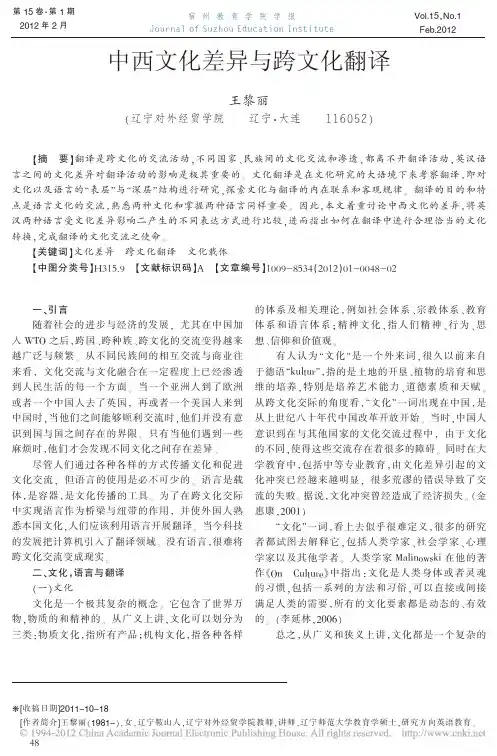
*[收稿日期]2011-10-18[作者简介]王黎丽(1981-),女,辽宁鞍山人,辽宁对外经贸学院教师,讲师,辽宁师范大学教育学硕士,研究方向英语教育。
一、引言随着社会的进步与经济的发展,尤其在中国加入WTO 之后,跨国、跨种族、跨文化的交流变得越来越广泛与频繁。
从不同民族间的相互交流与商业往来看,文化交流与文化融合在一定程度上已经渗透到人民生活的每一个方面。
当一个亚洲人到了欧洲或者一个中国人去了英国,再或者一个美国人来到中国时,当他们之间能够顺利交流时,他们并没有意识到国与国之间存在的界限。
只有当他们遇到一些麻烦时,他们才会发现不同文化之间存在差异。
尽管人们通过各种各样的方式传播文化和促进文化交流,但语言的使用是必不可少的。
语言是载体,是容器,是文化传播的工具。
为了在跨文化交际中实现语言作为桥梁与纽带的作用,并使外国人熟悉本国文化,人们应该利用语言开展翻译。
当今科技的发展把计算机引入了翻译领域。
没有语言,很难将跨文化交流变成现实。
二、文化,语言与翻译(一)文化文化是一个极其复杂的概念。
它包含了世界万物,物质的和精神的。
从广义上讲,文化可以划分为三类:物质文化,指所有产品;机构文化,指各种各样的体系及相关理论,例如社会体系、宗教体系、教育体系和语言体系;精神文化,指人们精神、行为、思想、信仰和价值观。
有人认为“文化”是一个外来词,很久以前来自于德语“kultur ”,指的是土地的开垦、植物的培育和思维的培养,特别是培养艺术能力、道德素质和天赋。
从跨文化交际的角度看,“文化”一词出现在中国,是从上世纪八十年代中国改革开放开始。
当时,中国人意识到在与其他国家的文化交流过程中,由于文化的不同,使得这些交流存在着很多的障碍。
同时在大学教育中,包括中等专业教育,由文化差异引起的文化冲突已经越来越明显,很多荒谬的错误导致了交流的失败。
据说,文化冲突曾经造成了经济损失。
(金惠康,2001)“文化”一词,看上去似乎很难定义,很多的研究者都试图去解释它,包括人类学家、社会学家、心理学家以及其他学者。
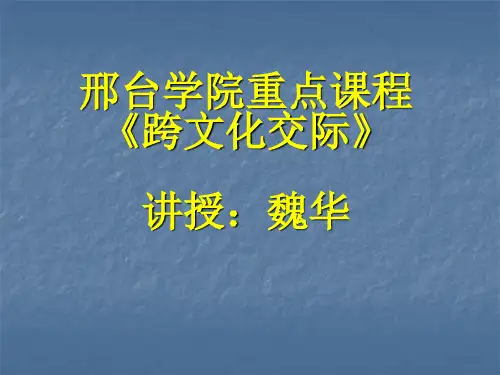

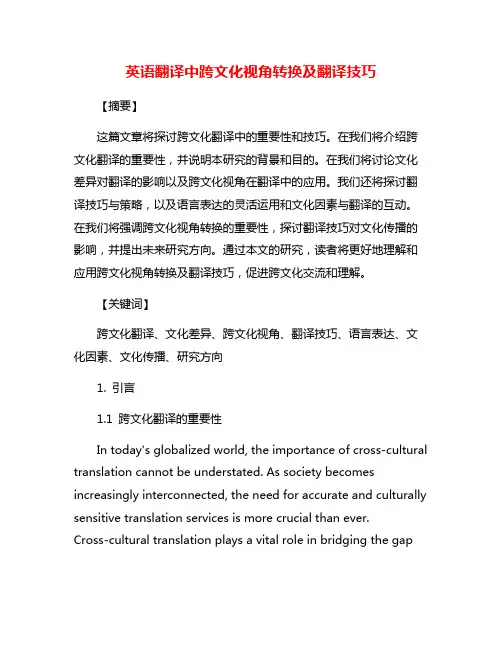
英语翻译中跨文化视角转换及翻译技巧【摘要】这篇文章将探讨跨文化翻译中的重要性和技巧。
在我们将介绍跨文化翻译的重要性,并说明本研究的背景和目的。
在我们将讨论文化差异对翻译的影响以及跨文化视角在翻译中的应用。
我们还将探讨翻译技巧与策略,以及语言表达的灵活运用和文化因素与翻译的互动。
在我们将强调跨文化视角转换的重要性,探讨翻译技巧对文化传播的影响,并提出未来研究方向。
通过本文的研究,读者将更好地理解和应用跨文化视角转换及翻译技巧,促进跨文化交流和理解。
【关键词】跨文化翻译、文化差异、跨文化视角、翻译技巧、语言表达、文化因素、文化传播、研究方向1. 引言1.1 跨文化翻译的重要性In today's globalized world, the importance of cross-cultural translation cannot be understated. As society becomes increasingly interconnected, the need for accurate and culturally sensitive translation services is more crucial than ever.Cross-cultural translation plays a vital role in bridging the gapbetween different languages and cultures, facilitating communication and understanding across borders.1.2 研究背景Cross-cultural translation is a rapidly growing field of study that investigates the complexities and challenges of conveying meanings across different cultures. The ability to accurately convey cultural nuances and subtleties in translation is essential for effective communication in a globalized world. The increasing globalization of communication and the growing demand for multicultural exchange have led to a heightened interest in cross-cultural translation.1.3 研究目的Through a comprehensive analysis of the application of cross-cultural perspectives in translation, we hope to provide insights into how translators can effectively navigate cultural nuances and ensure accurate and culturally sensitive translations. By exploring the strategies and techniques used in translation, we seek to highlight the importance of linguistic flexibility and cultural adaptability in achieving successful cross-cultural communication.2. 正文2.1 文化差异对翻译的影响文化差异对翻译的影响是一个非常重要的主题。
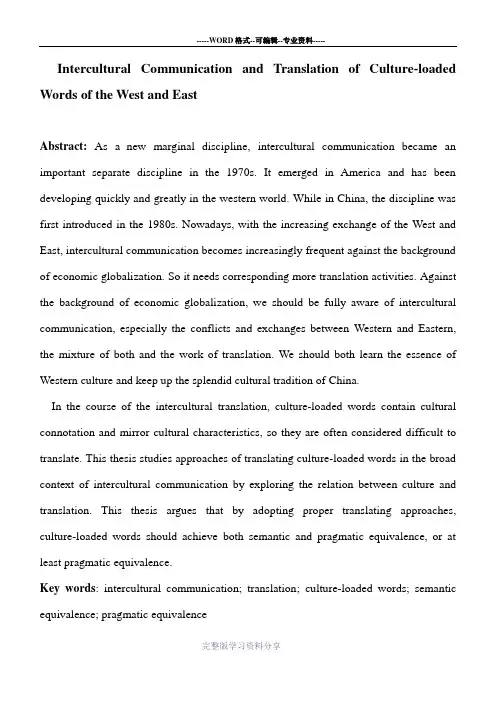
Intercultural Communication and Translation of Culture-loaded Words of the West and EastAbstract:As a new marginal discipline, intercultural communication became an important separate discipline in the 1970s. It emerged in America and has been developing quickly and greatly in the western world. While in China, the discipline was first introduced in the 1980s. Nowadays, with the increasing exchange of the West and East, intercultural communication becomes increasingly frequent against the background of economic globalization. So it needs corresponding more translation activities. Against the background of economic globalization, we should be fully aware of intercultural communication, especially the conflicts and exchanges between Western and Eastern, the mixture of both and the work of translation. We should both learn the essence of Western culture and keep up the splendid cultural tradition of China.In the course of the intercultural translation, culture-loaded words contain cultural connotation and mirror cultural characteristics, so they are often considered difficult to translate. This thesis studies approaches of translating culture-loaded words in the broad context of intercultural communication by exploring the relation between culture and translation. This thesis argues that by adopting proper translating approaches, culture-loaded words should achieve both semantic and pragmatic equivalence, or at least pragmatic equivalence.Key words: intercultural communication; translation; culture-loaded words; semantic equivalence; pragmatic equivalenceIntroductionIntercultural communication involves two different cultures, and different culture created a different national language. Culture plays an important role in specific semantic structure and model of language. The vocabulary is the accumulation of cultural information, and the cultural concepts and values of different nation at all levels of culture are "reflected in their vocabulary system, and then form the words with cultural connotation." [1]With special cultural connotation, cultural words are often difficult in cross-cultural communication translation, and even become an obstacle to transmission of information.Influence of culture on translationFrom the perspective of intercultural communication, one of the purposes is to establish the cultural equivalence between the source language and target language. In terms of the translation of cultural terms, the cultural equivalence mainly reflects in the semantic equivalence and pragmatic equivalence. Semantic equivalence is the basis of pragmatic equivalence. Thus, in many cases, equivalent translation is also mainly refers to the semantic equivalence.The author believes that the basic principles of cultural lexicon translation should be done to maximize the semantic and pragmatic equivalence. We should at least ensure the pragmatic equivalence if semantic equivalence can not be achieved. For instance, in Tianjin city of China, there is a century-old snack "Goubuli" steamed buns, and now many tourist cities in the country establish its branches, and the buns are also soldabroad. Its English translation "Dog Won't Leave" is far from its original Chinese name meaning. And there is no semantic equivalent at all, because the Chinese "dog ignore" have no contact with “the dog” and “leave”. However, from the perspective of pragmatic translation, “Dog Won't Leave” is a wonderful translation. Dogs won’t leave buns stands for it will not leave its host either. Undoubtedly, such translation has a strong attraction force for diners in English and America who love dogs like loving friends. Basically, the equivalence in pragmatic effects is achieved.As the source language and target language are different in language and culture, it is almost impossible to achieve totally equivalence in semantic and pragmatic aspect for the source language and target language symbols. Therefore, when translating cultural words, we only try to pursuit of semantic equivalence as far as possible under the premise of ensuring pragmatic equivalence. There are five commonly used methods when translating cultural words:First, shift translation. It refers to unchanged moving all or part of the source language to the target language. For instances, CD, VCD, DVD, DNA, ICU, and many computer terms which are translated into Chinese by the shift frequently appear on Chinese newspapers and magazines. Some expressions with Chinese characteristics like qigong (qigong), taijiquan (shadow boxing), jiaozi (dumplings), qipao (cheongsam), has moved in English and American newspapers.Second, transliteration. Some of the source language culture-specific images are "blank" or "vacant” in the target language. I n this case, we can transplant these unique to the target language using transliteration method. Transliteration is homophonic inChinese words or word combinations in English translation, and these words or word combinations are not meaningful ready-made words in Chinese. For instance: 秀(show), 酷(cool), 黑客(hacker), 艾滋病(AIDS), 色拉(salad), 可口可乐(Coca-cola) and so on.Third, literal translation. Literal translation refers to translation of the "corresponding" phrase and cultural information in the source language. This can preserve cultural identity of the source language as much as possible and broaden the cultural horizons of target language readers. However, it can not be applied mechanically, and it should not mislead the reader of the target language. For instance: olive branch (橄榄树), lonely as a cloud (像一朵孤云), 纸老虎(paper tiger),一国两制(one country with two systems), etc.Four, free translation. It focuses on the translation to convey the original meaning (interpretation), which lay down the language form and literal meaning of the source language. It expresses the cultural information of source language in the target language with cross-cultural "pragmatic equivalence. For instance: the Renaissance (文艺复兴); "辛亥革命"(the 1911 Revolution against Qing Dynasty), etc.Five, Replacement. It refers to the replacement of original words with some similar meaning but different concept meaning in the target language on the basis of keeping communication meaning of the original. That is to replace words with rich cultural connotation in the source language with corresponding word with same cultural connotation in the target language. Such as: to laugh off one's head (笑掉大牙); lead a dog's life (过着牛马不如的生活); 挥金如土(to spend money like water); 力大如牛(asstrong as a horse).ConclusionEnglish and Chinese are two different languages, and both reflect the cultural differences which form the barrier of communication. How to overcome obstacles and achieve cultural equivalence is a difficult problem to solve. Practice shows that in most cases we can find reasonable translation methods which can be accepted by readers in the target language. By means of the necessary modifications, we can at least achieve pragmatic equivalence. The important thing is that the translators should attach great importance to cultural factors in the source language, and consider issues from the purpose of intercultural communication.。
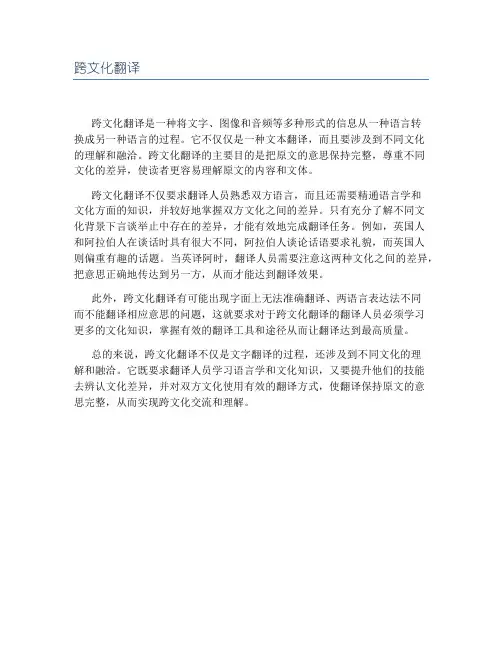
跨文化翻译
跨文化翻译是一种将文字、图像和音频等多种形式的信息从一种语言转
换成另一种语言的过程。
它不仅仅是一种文本翻译,而且要涉及到不同文化
的理解和融洽。
跨文化翻译的主要目的是把原文的意思保持完整,尊重不同
文化的差异,使读者更容易理解原文的内容和文体。
跨文化翻译不仅要求翻译人员熟悉双方语言,而且还需要精通语言学和
文化方面的知识,并较好地掌握双方文化之间的差异。
只有充分了解不同文
化背景下言谈举止中存在的差异,才能有效地完成翻译任务。
例如,英国人
和阿拉伯人在谈话时具有很大不同,阿拉伯人谈论话语要求礼貌,而英国人
则偏重有趣的话题。
当英译阿时,翻译人员需要注意这两种文化之间的差异,把意思正确地传达到另一方,从而才能达到翻译效果。
此外,跨文化翻译有可能出现字面上无法准确翻译、两语言表达法不同
而不能翻译相应意思的问题,这就要求对于跨文化翻译的翻译人员必须学习
更多的文化知识,掌握有效的翻译工具和途径从而让翻译达到最高质量。
总的来说,跨文化翻译不仅是文字翻译的过程,还涉及到不同文化的理
解和融洽。
它既要求翻译人员学习语言学和文化知识,又要提升他们的技能
去辨认文化差异,并对双方文化使用有效的翻译方式,使翻译保持原文的意
思完整,从而实现跨文化交流和理解。
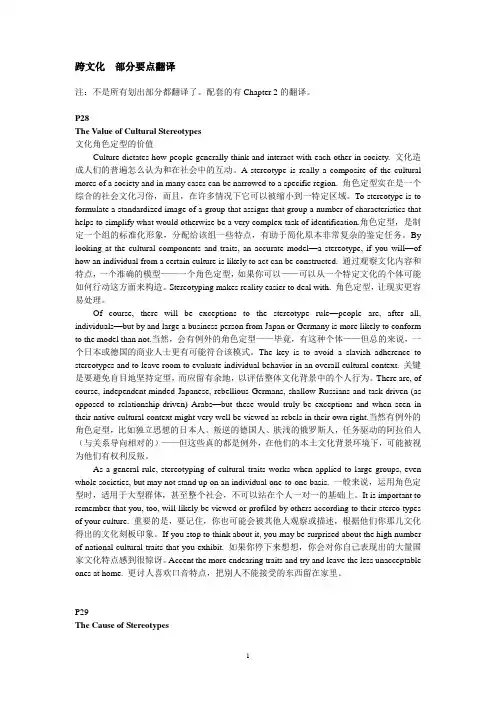
跨文化部分要点翻译注:不是所有划出部分都翻译了。
配套的有Chapter 2的翻译。
P28The Value of Cultural Stereotypes文化角色定型的价值Culture dictates how people generally think and interact with each other in society.文化造成人们的普遍怎么认为和在社会中的互动。
A stereotype is really a composite of the cultural mores of a society and in many cases can be narrowed to a specific region.角色定型实在是一个综合的社会文化习俗,而且,在许多情况下它可以被缩小到一特定区域。
To stereotype is to formulate a standardized image of a group that assigns that group a number of characteristics that helps to simplify what would otherwise be a very complex task of identification.角色定型,是制定一个组的标准化形象,分配给该组一些特点,有助于简化原本非常复杂的鉴定任务。
By looking at the cultural components and traits, an accurate model—a stereotype, if you will—of how an individual from a certain culture is likely to act can be constructed.通过观察文化内容和特点,一个准确的模型——一个角色定型,如果你可以——可以从一个特定文化的个体可能如何行动这方面来构造。
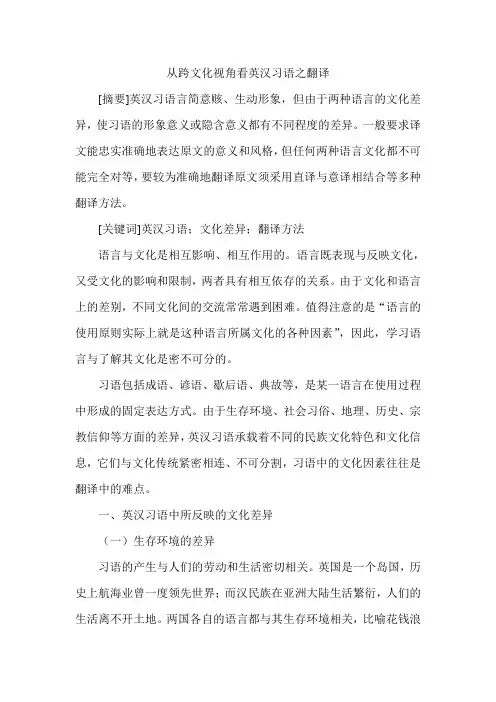
从跨文化视角看英汉习语之翻译[摘要]英汉习语言简意赅、生动形象,但由于两种语言的文化差异,使习语的形象意义或隐含意义都有不同程度的差异。
一般要求译文能忠实准确地表达原文的意义和风格,但任何两种语言文化都不可能完全对等,要较为准确地翻译原文须采用直译与意译相结合等多种翻译方法。
[关键词]英汉习语;文化差异;翻译方法语言与文化是相互影响、相互作用的。
语言既表现与反映文化,又受文化的影响和限制,两者具有相互依存的关系。
由于文化和语言上的差别,不同文化间的交流常常遇到困难。
值得注意的是“语言的使用原则实际上就是这种语言所属文化的各种因素”,因此,学习语言与了解其文化是密不可分的。
习语包括成语、谚语、歇后语、典故等,是某一语言在使用过程中形成的固定表达方式。
由于生存环境、社会习俗、地理、历史、宗教信仰等方面的差异,英汉习语承载着不同的民族文化特色和文化信息,它们与文化传统紧密相连、不可分割,习语中的文化因素往往是翻译中的难点。
一、英汉习语中所反映的文化差异(一)生存环境的差异习语的产生与人们的劳动和生活密切相关。
英国是一个岛国,历史上航海业曾一度领先世界;而汉民族在亚洲大陆生活繁衍,人们的生活离不开土地。
两国各自的语言都与其生存环境相关,比喻花钱浪费,大手大脚,英语是spend money like water,而汉语是“挥金如土”。
英语中有许多关于船和水的习语,在汉语中没有完全相对应的习语,如to hold water(指辩论、接口、理论等经得起检验的,站得住脚的),between the devil and the deep blue sea(进退维谷,左右为难)等等。
在汉语的文化氛围中,东风是“春天的风”,而east wind(东风)在英国是从北冰洋刮来的刺骨寒风,给英国民族带来不好的心理反应。
因此在翻译“东风”时我们应附加一些信息作为脚注,这样英国人才不会对这个词有心理上的错解了。
英国地处西半球,北温带,海洋性气候,这里报告春天消息的是西风,西风对于英国人是暖风,是生命的催生剂。
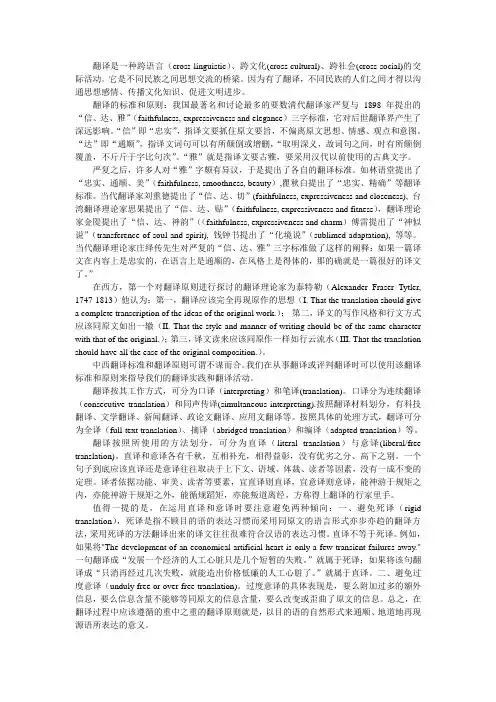
翻译是一种跨语言(cross-linguistic)、跨文化(cross-cultural)、跨社会(cross-social)的交际活动。
它是不同民族之间思想交流的桥梁。
因为有了翻译,不同民族的人们之间才得以沟通思想感情、传播文化知识、促进文明进步。
翻译的标准和原则:我国最著名和讨论最多的要数清代翻译家严复与1898年提出的“信、达、雅”(faithfulness, expressiveness and elegance)三字标准,它对后世翻译界产生了深远影响。
“信”即“忠实”,指译文要抓住原文要旨,不偏离原文思想、情感、观点和意图。
“达”即“通顺”,指译文词句可以有所颠倒或增删,“取明深义,故词句之间,时有所颠倒覆盖,不斤斤于字比句次”。
“雅”就是指译文要古雅,要采用汉代以前使用的古典文字。
严复之后,许多人对“雅”字颇有异议,于是提出了各自的翻译标准。
如林语堂提出了“忠实、通顺、美”(faithfulness, smoothness, beauty),瞿秋白提出了“忠实、精确”等翻译标准。
当代翻译家刘重德提出了“信、达、切”(faithfulness, expressiveness and closeness), 台湾翻译理论家思果提出了“信、达、贴”(faithfulness, expressiveness and fitness),翻译理论家金隄提出了“信、达、神韵”((faithfulness, expressiveness and charm)傅雷提出了“神似说”(transference of soul and spirit), 钱钟书提出了“化境说”(sublimed adaptation), 等等。
当代翻译理论家庄绎传先生对严复的“信、达、雅”三字标准做了这样的阐释:如果一篇译文在内容上是忠实的,在语言上是通顺的,在风格上是得体的,那的确就是一篇很好的译文了。
”在西方,第一个对翻译原则进行探讨的翻译理论家为泰特勒(Alexander Fraser Tytler, 1747-1813)他认为:第一,翻译应该完全再现原作的思想(I. That the translation should give a complete transcription of the ideas of the original work.);第二,译文的写作风格和行文方式应该同原文如出一辙(II. That the style and manner of writing should be of the same character with that of the original.);第三,译文读来应该同原作一样如行云流水(III. That the translation should have all the ease of the original composition.)。
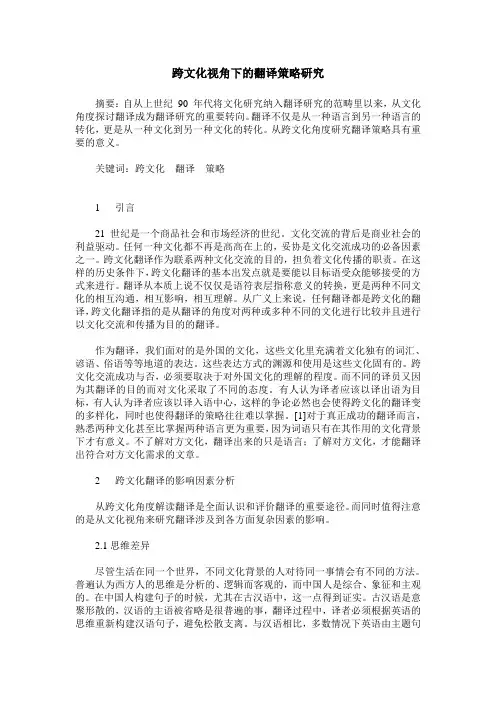
跨文化视角下的翻译策略研究摘要:自从上世纪90 年代将文化研究纳入翻译研究的范畴里以来,从文化角度探讨翻译成为翻译研究的重要转向。
翻译不仅是从一种语言到另一种语言的转化,更是从一种文化到另一种文化的转化。
从跨文化角度研究翻译策略具有重要的意义。
关键词:跨文化翻译策略1 引言21世纪是一个商品社会和市场经济的世纪。
文化交流的背后是商业社会的利益驱动。
任何一种文化都不再是高高在上的,妥协是文化交流成功的必备因素之一。
跨文化翻译作为联系两种文化交流的目的,担负着文化传播的职责。
在这样的历史条件下,跨文化翻译的基本出发点就是要能以目标语受众能够接受的方式来进行。
翻译从本质上说不仅仅是语符表层指称意义的转换,更是两种不同文化的相互沟通,相互影响,相互理解。
从广义上来说,任何翻译都是跨文化的翻译,跨文化翻译指的是从翻译的角度对两种或多种不同的文化进行比较并且进行以文化交流和传播为目的的翻译。
作为翻译,我们面对的是外国的文化,这些文化里充满着文化独有的词汇、谚语、俗语等等地道的表达。
这些表达方式的渊源和使用是这些文化固有的。
跨文化交流成功与否,必须要取决于对外国文化的理解的程度。
而不同的译员又因为其翻译的目的而对文化采取了不同的态度。
有人认为译者应该以译出语为目标,有人认为译者应该以译入语中心,这样的争论必然也会使得跨文化的翻译变的多样化,同时也使得翻译的策略往往难以掌握。
[1]对于真正成功的翻译而言,熟悉两种文化甚至比掌握两种语言更为重要,因为词语只有在其作用的文化背景下才有意义。
不了解对方文化,翻译出来的只是语言;了解对方文化,才能翻译出符合对方文化需求的文章。
2 跨文化翻译的影响因素分析从跨文化角度解读翻译是全面认识和评价翻译的重要途径。
而同时值得注意的是从文化视角来研究翻译涉及到各方面复杂因素的影响。
2.1思维差异尽管生活在同一个世界,不同文化背景的人对待同一事情会有不同的方法。
普遍认为西方人的思维是分析的、逻辑而客观的,而中国人是综合、象征和主观的。
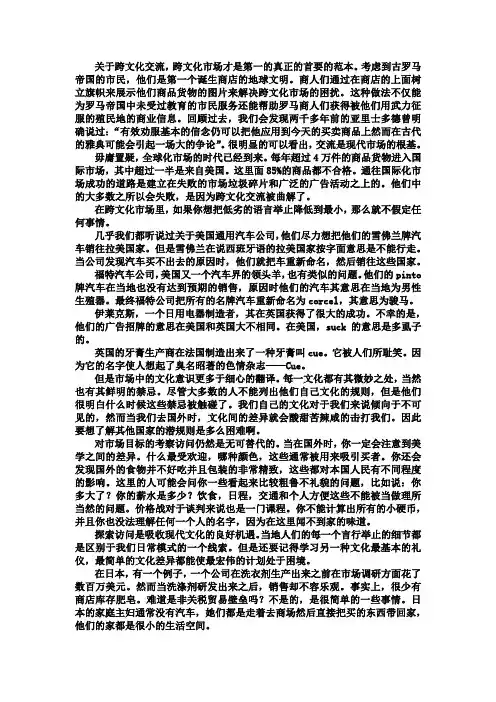
关于跨文化交流,跨文化市场才是第一的真正的首要的范本。
考虑到古罗马帝国的市民,他们是第一个诞生商店的地球文明。
商人们通过在商店的上面树立旗帜来展示他们商品货物的图片来解决跨文化市场的困扰。
这种做法不仅能为罗马帝国中未受过教育的市民服务还能帮助罗马商人们获得被他们用武力征服的殖民地的商业信息。
回顾过去,我们会发现两千多年前的亚里士多德曾明确说过:“有效劝服基本的信念仍可以把他应用到今天的买卖商品上然而在古代的雅典可能会引起一场大的争论”。
很明显的可以看出,交流是现代市场的根基。
毋庸置疑,全球化市场的时代已经到来。
每年超过4万件的商品货物进入国际市场,其中超过一半是来自美国。
这里面85%的商品都不合格。
通往国际化市场成功的道路是建立在失败的市场垃圾碎片和广泛的广告活动之上的。
他们中的大多数之所以会失败,是因为跨文化交流被曲解了。
在跨文化市场里,如果你想把低劣的语言举止降低到最小,那么就不假定任何事情。
几乎我们都听说过关于美国通用汽车公司,他们尽力想把他们的雪佛兰牌汽车销往拉美国家。
但是雪佛兰在说西班牙语的拉美国家按字面意思是不能行走。
当公司发现汽车买不出去的原因时,他们就把车重新命名,然后销往这些国家。
福特汽车公司,美国又一个汽车界的领头羊,也有类似的问题。
他们的pinto 牌汽车在当地也没有达到预期的销售,原因时他们的汽车其意思在当地为男性生殖器。
最终福特公司把所有的名牌汽车重新命名为corcel,其意思为骏马。
伊莱克斯,一个日用电器制造者,其在英国获得了很大的成功。
不幸的是,他们的广告招牌的意思在美国和英国大不相同。
在美国,suck的意思是多虱子的。
英国的牙膏生产商在法国制造出来了一种牙膏叫cue。
它被人们所耻笑。
因为它的名字使人想起了臭名昭著的色情杂志——Cue。
但是市场中的文化意识更多于细心的翻译。
每一文化都有其微妙之处,当然也有其鲜明的禁忌。
尽管大多数的人不能列出他们自己文化的规则,但是他们很明白什么时候这些禁忌被触碰了。
跨国文化的英语作文带翻译Title: Embracing Cross-Cultural Connections through English。
In our interconnected world, the ability to navigate across cultures is increasingly essential. English, as a global lingua franca, plays a pivotal role in facilitating cross-cultural communication. In this essay, we will explore the significance of cross-cultural understanding and how English serves as a bridge between diverse societies.First and foremost, cross-cultural interactions foster empathy and tolerance. When individuals engage with people from different cultural backgrounds, they gain insightsinto alternative worldviews and ways of life. This exposure broadens their perspective, making them more receptive to diversity and less prone to prejudice. Through English, people from diverse linguistic backgrounds can communicate effectively, transcending linguistic barriers and fosteringmutual understanding.Moreover, English proficiency opens doors to a wealth of opportunities in the globalized job market. In multinational corporations, proficiency in English is often a prerequisite for international assignments and collaborations. Employees who are adept in English can seamlessly navigate multicultural work environments, contributing to innovation and productivity. Additionally, English fluency enhances one's employability, as it enables individuals to access a vast array of resources, ranging from online courses to academic literature, furtheringtheir professional development.Furthermore, English serves as a medium for cultural exchange and mutual enrichment. Through literature, film, music, and other forms of artistic expression, individuals can immerse themselves in diverse cultures and gain a deeper appreciation for humanity's rich tapestry. For instance, reading novels by authors from different countries allows readers to vicariously experience life through varied cultural lenses. Similarly, watching foreignfilms with English subtitles enables audiences to explore unfamiliar narratives and aesthetic traditions.It is important to recognize that embracing cross-cultural connections through English requires humility and open-mindedness. Language is deeply intertwined with culture, and nuances in communication can easily be misunderstood without cultural context. Therefore, learners of English must approach language acquisition with a genuine curiosity about different cultures, seeking to learn not only grammar and vocabulary but also cultural norms and values.In conclusion, English serves as a powerful tool for bridging cultural divides and fostering global citizenship. By promoting empathy, facilitating professional opportunities, and facilitating cultural exchange, English empowers individuals to engage with the world in meaningful ways. As we continue to navigate an increasingly interconnected world, let us embrace the richness of diversity and harness the potential of English to build bridges across cultures.中文翻译:标题,通过英语拥抱跨文化交流。
跨文化翻译的基本概念和策略作者:朱素平来源:《科教导刊》2009年第22期摘要翻译是一种把语言文字(文化)的意义用另一种语言文字表达出来。
跨文化交际的本质就是一种文化对话,从广义上来说,是指不同民族文化传统相互影响,而狭义的文化对话是指不同民族的代表为交流信息所进行的接触,其间,翻译就是这种文化对话的有效中介,起着极其重要的作用。
关键词跨文化翻译基本概念策略中图分类号:H059文献标识码:A翻译是一种把语言文字(文化)的意义用另一种语言文字表达出来。
从现代符号学的观点来说,翻译的本质就是以两种不同的语言符号来表达同一的思想。
因此可以说翻译是跨文化交际,这就不止是原语文本的符号再现,而是体现在跨文化意义的传达和转换。
翻译体现了不同文化的价值观,传统习俗等不同的特点和其多样性。
跨文化交际的本质就是一种文化对话,从广义上来说,是指不同民族文化传统相互影响,而狭义的文化对话是指不同民族的代表为交流信息所进行的接触,其间,翻译就是这种文化对话的有效中介,起着极其重要的作用。
1 跨文化翻译的概念跨文化翻译要求译语要从文化的角度准确地再现原语所要传达的意义、方式及其风格。
意思就是说中心任务就是再现原文的思想,而不是原文的语言符号,并将其原语中的形、神在译语中体现出来。
这就对译者提出了更高的要求,不仅要有双语能力,还要有双语文化甚至是多文化的知识,尤其是对两种语言的文化形成过程、心里意识、历史习俗、宗教文化等各个方面都要有一定的了解。
所以,正是由于这这些因素,英汉民族的语言才能体现出各自特有的民族色彩。
2 跨文化翻译的两种策略——归化和异化由于语言是文化的载体,是文化的传播途径,而文化具有独特的民族特征,因此在语言翻译中必须考虑如何处理源文化与目的语文化的差异。
译者可以选择归化或异化的方法,前者是以民族主义为中心,把外国的价值观归化到目的语文化之中,把原文作者请回家来; 后者则以偏离主义为中心,离经叛道地把外国文本中的语言和文化差异表现出来,把读者送到外国去。
Speaki ng Englis h with a Japane se mind 日本人在达到上学年龄后就要学英语,这些人在学会英语之后就可能用英语进行对外交流,但是他们所使用的英语要受到他们本民族的语言和文化的影响。
因此这就会造成困扰和误解在与其他用英语的人交流时。
AM,当他作为索尼公司的首席执行官时,在一次给美国的商学会做报告时他指出了这两种语言的明显差异。
他举了一个例子,一个美国商人向他的一个日本生意上的伙伴提议了一项计划。
可是当美国人完成时,日本人才开始谈论这个项目听起来多么有趣并且他们公司也有同样的想法。
美国人认为这个项目肯定会被接受。
但是随着辩论的拖延,美国人的关注也开始减弱,然后日本人说,不管怎样。
AM告诫说,接下来就是你要仔细听的时候了。
因为真正的回答是在那个词语的后面。
他经常告诫他的部下官员要用一种大多数的使用英语的人都习惯的方式说话,如果他想被别人理解。
他还告诫说,在日本你可能是大多数,但是到了国外你就是一小部分。
要想用一种大多数人都能最大限度的理解你的方式说话需要更多的语法知识和大量的词汇。
你必须对你所谈话的那个人的交流方式,社交礼仪,价值观等等很熟悉。
日本人的说话顺序正好和说英语的人相反。
甚至就是一个非常简单的句子,比如英国人会说,你得带伞因为要下雨。
而日本人会说,因为会下雨所以你要带伞。
不管这种正常的表达方式的顺序是否会控制想法顺序还是什么,日本人这种用不同顺序的表达信息的方式会让那些说英语的国家的人且对日本语言不了解的人感到困惑。
另一个例子就是,一些说英语的日本人和美国的一些领导举行卫星电视会议来讨论两国间的经济和贸易关系。
日本的参会者说着流利的英语,同时会被翻译成日语以供那些不懂得英语的人理解。
翻译基础知识总结1.异化(foreignization) 和归化(domestication)保留原语所包含的文化、形象色彩,叫异化,读者通过这样的译文可以感受到异域文化的东西。
例如,把crocodile tears 译为鳄鱼泪,就是异化的翻译方法;舍弃原语所包含的文化、形象色彩,取而代之用译文的文化色彩,或者牺牲这种文化色彩而只翻译出其意义就是归化,就是让原文“归顺”于译文。
例如把crocodile tears 译为假惺惺的眼泪,就是归化的翻译方法。
2.直译(literal translation) 和意译(free translation) 直译即照着原文直接翻译,例如藏龙卧虎– Hidden dragons and hidden tigers. 意译就是抛弃原文形式而只传达其意义,例如Dutch courage –酒后之勇3.音译(transliteration) 比如:store –士多cheese –汁斯风水–fungshui4.翻译的标准:信达雅faithfulness, expressiveness, elegance “信”指的是忠实于原文的内容和风格(faithful to the content and style of the source text;“达”指的是译文语言流畅自然而不生硬阻滞(the translation or target text should be natural and expressive);“雅”指的是译文译文语言风格尽可能贴近原文风格。
5.词类的转化conversion :名词动词形容词副词根据表达需要,在翻译中,往往需要进行词类的转化,此外,还包括抽象与具体的转化。
6.增添法amplification 比如:增添连接词、范畴词、冠词、介词等等7.省略法omission比如:省略连接词、范畴词、冠词、介词等等8.汉语是意合(parataxis)语言,分句之间的关系是隐性的(covert),英语是形合(hypotaxis) 语言,分句之间关系还是显性的(overt)9.英语的54种基本句型:SV / SVC / SVO / SVOO / SVOC (参考教材15面)10.比较来说,汉语是动态(dynamic) 语言英语是静态( static) 语言;汉语更喜欢使用有灵主语(及人或其他有生命的词作主语animate subject),英语更喜欢无灵主语(inaminate subject),例如:The sight of the photo reminded me of ...(参考教材31面)11.句子层次来说,英译汉常要分division, 汉译英常要合combination.翻译部分题型:一、篇章汉译英(15分):请注意词的处理技巧的恰当运用,以及句子的组合。
跨文化因素对英汉翻译的影响引言最完美的英汉翻译应该要尽可能地传递原文化内涵,所以译者需要对英汉两种文化深入了解,因此本文将着重进行英汉两种文化的对比研究。
旨在通过细致全面的分析英汉差异形成的各方面原因和文化因素对英汉翻译的三种影响,尽量帮助英汉翻译者最大限度地了解东西方文化以及因文化差异对英汉翻译带来的各种影响。
从而使译者能真实地再现原文的面貌,体现原文化内涵,让翻译的精髓能真正体现在文化信息的传递。
一、跨文化定义所谓“跨文化”是指在全球化中,社会流动性增加和种族混杂造成的一种社会现象。
这种现象的本质是改变传统和现存的文化,是创造新文化。
跨文化在国际交往日益频繁、全球经济一体化的今天是被视作非常重要的。
在英语的过程中有很多问题,其实并不是英语好就表示你的沟通能力强,我们沟通的目的是要让对方真正理解到了我所要表达的意思,达到真正的会心交谈,而不是为了让对方称赞我的语言表达水平在那夸夸其谈。
二、文化与翻译美国著名翻译理论家尤金·奈达曾在其著作《语言、文化与翻译》(Language Culture and Translation)说过:“The role the Language plays in culture and the influence on the meaning of words and idioms are so common that no one can understand it properly without taking the language cultural background into account”“(语言在文化中的作用以及文化对文字和成语的影响是如此的普遍,如果不熟悉语言文化背景,没有人能够很好地理解其中含义。
”)尤金·奈达认为那些出现在书前面翻译与口译时的严重错误往往不是因为不恰当的表达方式引起的,而是缘于对文化的误解。
也就是说,中国与说英语国家之间存在的文化差异必然在翻译过程中产生影响。